Johnson rifle goes to war
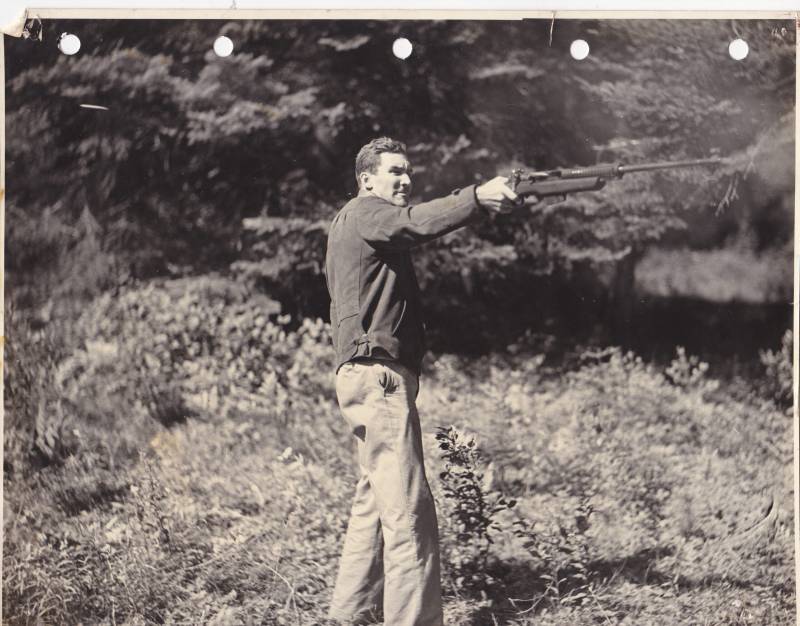
Melvin Johnson fires one of his early self-loading rifles with one hand. He liked to demonstrate lightness in this way. weapons and little return.
Johnson was an active critic of the Garand rifle system. In his opinion, he offered a much more perfect and reliable system. His criticism was well founded. The Garanda rifle, adopted in 1936 under the designation M1, suffered from childhood illnesses and could not boast of high reliability. But the system had already been put into service, production was being deployed, problems with the reliability of the automation were resolved in 1940 (the gas exhaust unit was completely redone), so the Johnson rifle was left out of work.
When it seemed that there were no prospects for a self-loading rifle, Johnson was approached by representatives of the Dutch Purchasing Commission in the United States. They were looking for weapons for the Royal Dutch East Indies Army. It was clear that a confrontation with Japan would happen sooner or later, and they wanted to re-equip the army of the pearl of the Dutch colonial empire with modern weapons. In the USA, the Dutch bought Tanks, small arms and even ... sabers - Dutch klevangs.
So on August 19, 1940, Johnson received an order for 10 rifles. Subsequently, it was expanded by another 200 pieces.
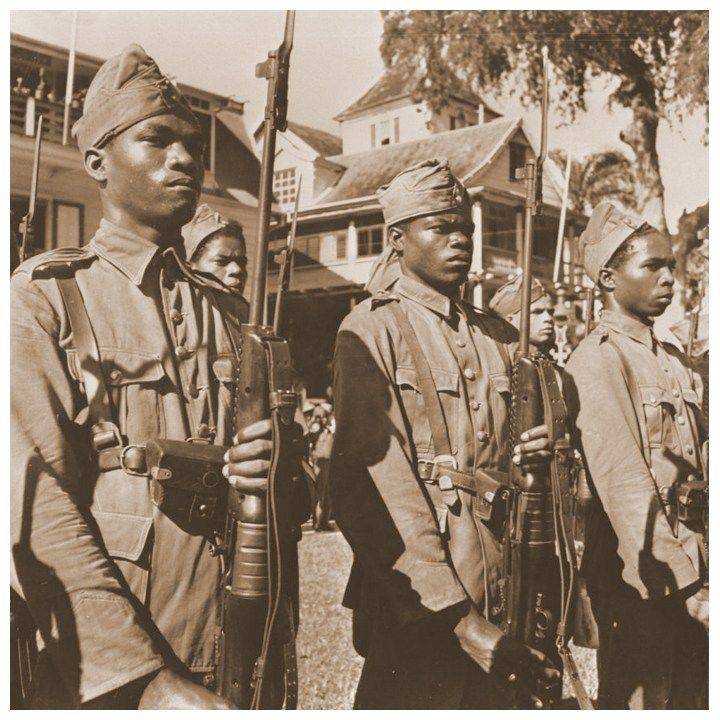
Soldiers of the Dutch colonial units with Johnson rifles. True, the photo is post-war. In repelling the Japanese invasion of the Dutch East Indies, these weapons practically did not take part.
And things went. Serial production has begun. True, at the time of signing the contract, Johnson did not have his own production. So a textile company was bought and an arms company, Cranston Arms Company, was created on its basis. The Dutch paid for everything...
And then there was the war. First, Holland itself fell in Europe, and in March 1942 the Dutch East Indies also collapsed. Before the occupation, the Dutch managed to send about 3 rifles. By that time, the United States, which had entered the war, was deploying military forces, and this opened up new opportunities for Johnson.
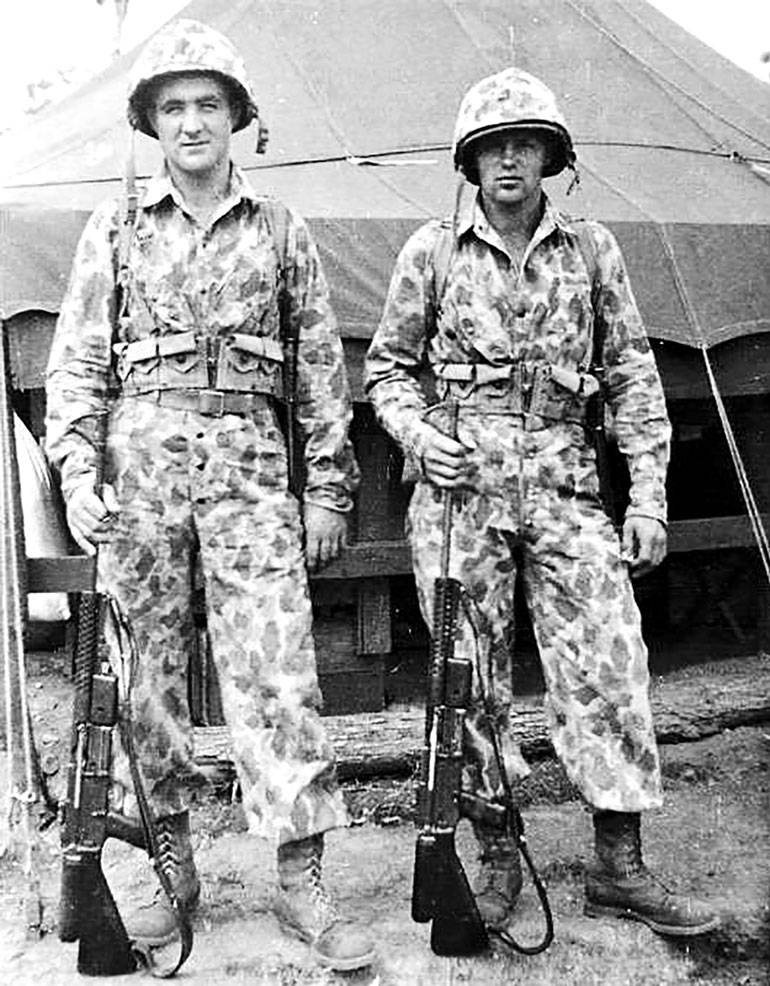
A pair of fighters from one of the landing battalions of the US Marine Corps with machine guns of the Johnson system.
The US Marine Corps was also actively deploying new units and formations. If in the interwar period the possibility of dissolving this “division fleet"and the transfer of all its functions to the army, then with the outbreak of war it became clear that the role of the USMC in the coming war would be significant.
The Marines did not bypass their attention and such a new-fangled branch of the military as the airborne troops. As part of the USMC, they began to deploy parts of paratroopers - paramarines. It was the Marine Corps paratroopers who turned their attention to the Johnson light machine gun. The automatics of the machine gun worked from the recoil of the barrel during its short course, the barrel was removable, respectively, the machine gun was easily disassembled and was compact during transportation, which attracted paratroopers very much.
In addition, a 30-round box magazine was a clear plus, in contrast to the 20-round magazine for the Browning automatic rifle, which was already in service with the USMC. After a series of tests, the machine gun was put into service, and its deliveries began.
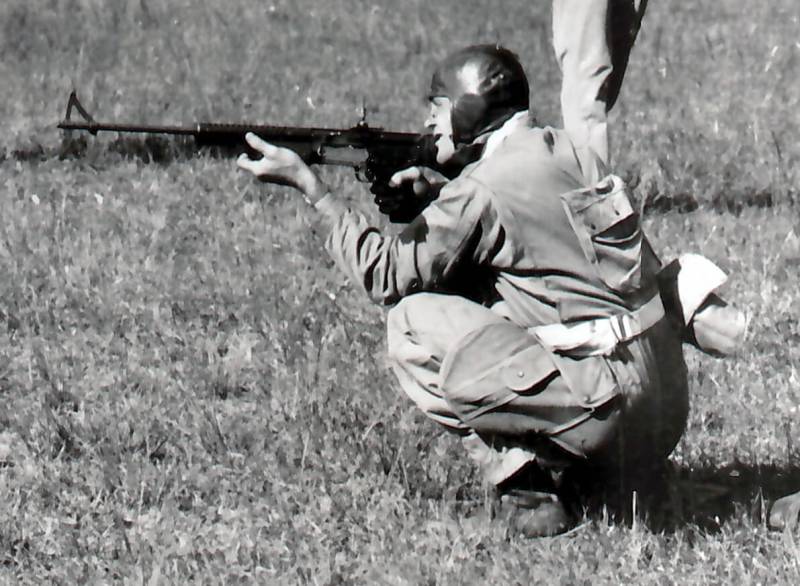
USMC Lieutenant Harry Togerson fires a Johnson machine gun during field trials of this weapon system, 1941. Pay attention to the landing suit and leather landing helmet, the unique uniform of paramarines. The USMC paratroopers were distinctive within the US armed forces and developed separately from the army paratroopers.
In 1942, the 1st parachute battalion of the USMC was sent to the combat zone. Johnson, himself a captain in the Marine Corps reserve, decided to give the paratroopers, already armed with his machine guns, a gift. He gave the paramarines 23 rifles of his design from the stocks of his weapons company.
A well-established in-line production made it possible, when fulfilling the Dutch order, to make a stock of spare parts, from which it was then possible to assemble more than 1 rifles. Some of them in caliber 000 × 7 Mauser were sold in Chile, and the rest in caliber 57-30 Springfield (06 × 7,62 mm) remained at the disposal of Johnson's company. It was from these own stocks that the gift was made.
The rifle proved to be very good in the war zone. In December 1942, Look magazine published an article about Sergeant Harry Tully of the 1st Paramarine Battalion, who received the Silver Star medal by destroying 42 Japanese soldiers with a Johnson rifle, most from a distance of about 800 yards (more than 700 meters).
In October 1942, the soldiers of the 2nd paramarine battalion, who also had to go overseas, said - but we also want to! In this case, we were talking about full-fledged armament of the battalion with Johnson self-loading rifles, and not about piece samples from the category - one per platoon.
Johnson no longer had such a number of rifles; there was also no talk of launching production and purchasing rifles. But in the United States, rifles lay idle, never sent to the Dutch. The US government approached Dutch East Indies officials in exile, and they gave the go-ahead to use 650 rifles from their stock.
There was a unique situation - a rifle that was not purchased by the US government or any government agency, and did not even pass official acceptance, entered service with one of the parts of the armed forces.
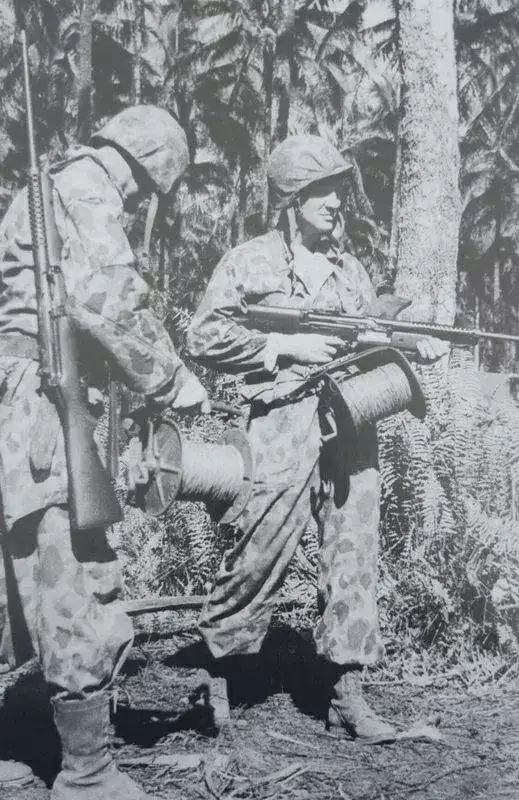
Signalers of the 1st Paramarine Regiment of the USMC are laying a telephone line, Bougainville Island, 1943. Both fighters are armed with Johnson-designed weapon systems, a self-loading rifle and a machine gun.
And then there was the 3rd battalion and the same request, but then the Dutch stood up and said - no!
In April 1943, the formation of a single unit began from three landing battalions - the 1st paramarine regiment of the USMC. The regiment officially received 242 Johnson rifles, and some of them did end up in the 3rd battalion. All of them were from those 650 that were issued by the Dutch and, apparently, just these 242 managed to enter service with the 2nd battalion, and from there they got into the newly formed regiment. The remaining 400-odd remained in American warehouses, to later return to the Dutch.
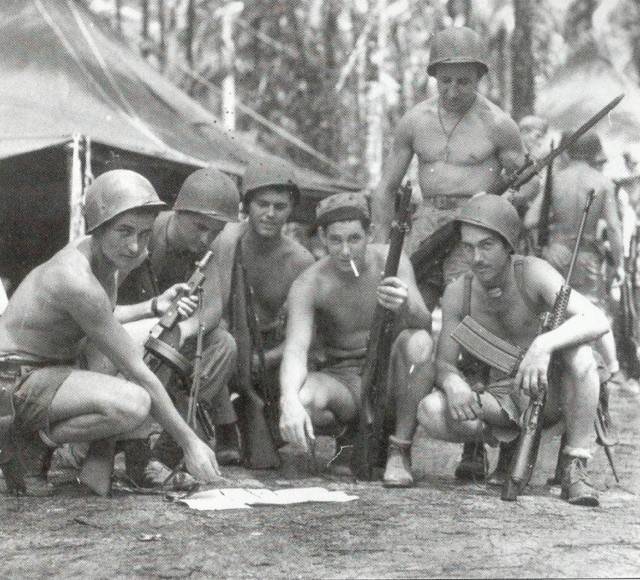
Group of paramarines of the 3rd battalion of the 1st regiment, 1943. One of the fighters has a Johnson machine gun. It is clearly seen that the M1903 bolt-action rifles and M1 self-loading rifles form the basis of small arms.
And then there were battles on the island of Bougainville and the disbandment of paramarines. The US Marine Corps decided that it no longer needed the amphibious units. Although several successful amphibious operations were carried out by army parachute units in the Pacific theater of operations before the end of the war, the command of the USMC decided that this was “not their method”, and completely focused on amphibious operations.
At the end of the fighting on the island of Bougainville, paramarines leaving the island were ordered to get rid of all non-standard weapons. This concerned primarily Johnson rifles. Rifles that had already fought and had never been officially adopted, it was decided to simply dispose of them.
There were no longer any problems with the number of self-loading rifles of the Garanda system, and it was even a shame to return to the Dutch rifles that had passed several months of fighting in the extreme conditions of the jungle of the northern Solomon Islands. The rifles were taken apart and simply buried.
But not all Marines were in a hurry to get rid of the weapons they loved. Clifford Goodin, an ordinary paramarine, recalled that he buried the barrel of a rifle on the beach, and hid the rifle itself in a duffel bag and later simply mailed it home in parts. At least one rifle fought until the end of the war, as we know from award documents.
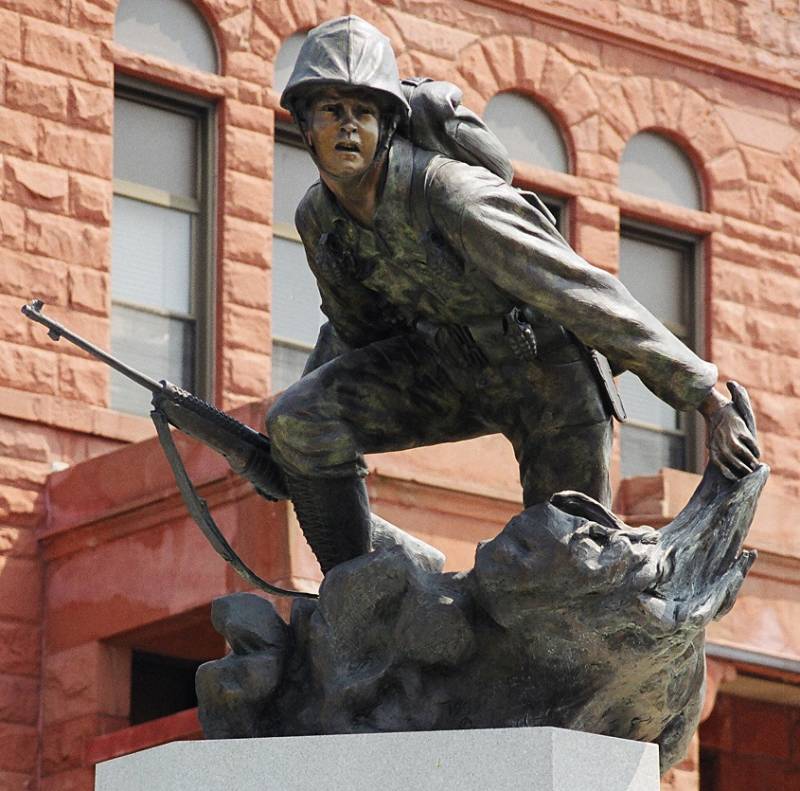
Monument in memory of USMC Captain Hugo Dunlop, Warrent County, USA. The captain is depicted with a Johnson rifle in his hands.
Hugo Dunlap (Robert H. Dunlap) was a college student when the US entered the war. In 1942, he went to enlist as a volunteer in the United States Marine Corps. There he was assigned to the reserve and allowed to finish his studies, after which he was sent to officer courses.
In 1943, the young lieutenant volunteered to join the 3rd Battalion, 1st Paramarine Regiment. In the same 1943, at the end of the Bougainville campaign, Dunlop decides to keep the rifle with which he fought for several months. The logic was simple - this non-standard weapon is officially considered decommissioned, which means that it does not exist, and what does not exist cannot be stolen, it turns out that nothing will be done to it. Ahead was a return to the United States, then a training camp in the Hawaiian Islands and an assignment to the newly formed 5th division of the USMC. All this time Johnson's rifle was with Dunlop.
And now it's time to land on the island of Iwo Jima. Company "C" of the 1st Battalion, 26th Regiment, commanded by Dunlop, on the outskirts of Mount Suribachi comes under heavy machine-gun and mortar fire. The Marines lie down, the advance stops completely, the losses grow. Dunlop, already a captain, decides to scout the Japanese positions himself. Japanese positions camouflaged in caves and rocks were often difficult to detect even from the air. It was necessary to crawl almost close to understand where the fire was coming from, but Dunlop succeeded, then managed to return unscathed to his unit and transmit the coordinates of the targets to the invasion ships, causing the ship's artillery to fire. Japanese positions were destroyed, the advance continued.
Over the next two days, Dunlop personally reconnoitered Japanese positions several times and corrected the fire of naval artillery, which ensured the advance of his company and, ultimately, the capture of Mount Suribachi. And then there was a wound and evacuation, first to Guam, and then to the USA, for several months in a hospital bed, most of them in a plaster corset. On December 18, 1945, Dunlop and five other American servicemen at the White House were presented with the Medal of Honor by US President Harry Truman.
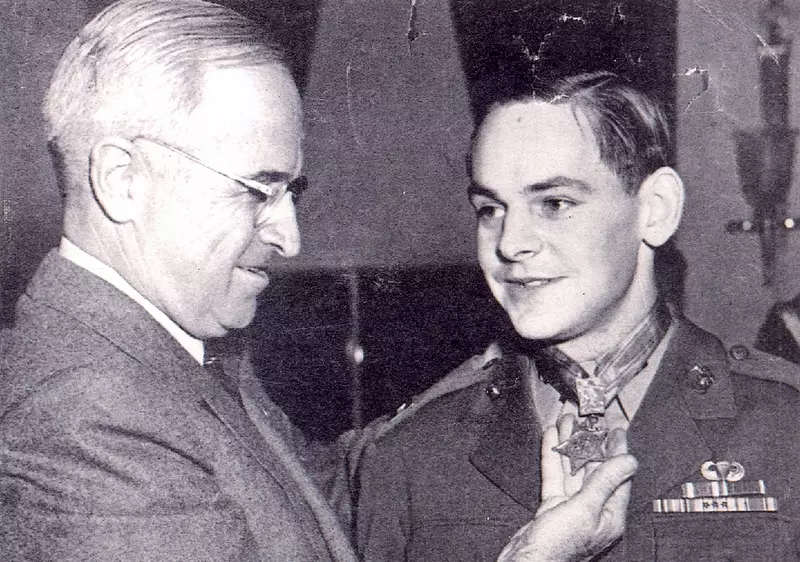
Official photo on December 18, 1945.
And then there will be promotion to major, transfer to the reserve, a happy family life, two children, 18 years of farming, and then a job as a teacher until retirement. Dunlop died at the age of 79 in March 2000. And all this time Dunlop had his Johnson rifle next to him. He was not only able to take it with him to the hospital from Iwo Jima, but also kept it for himself after being transferred to the reserve (the rifle was officially disposed of). The rifle was kept in his house until his death, and he willingly showed it to friends and guests of his house.
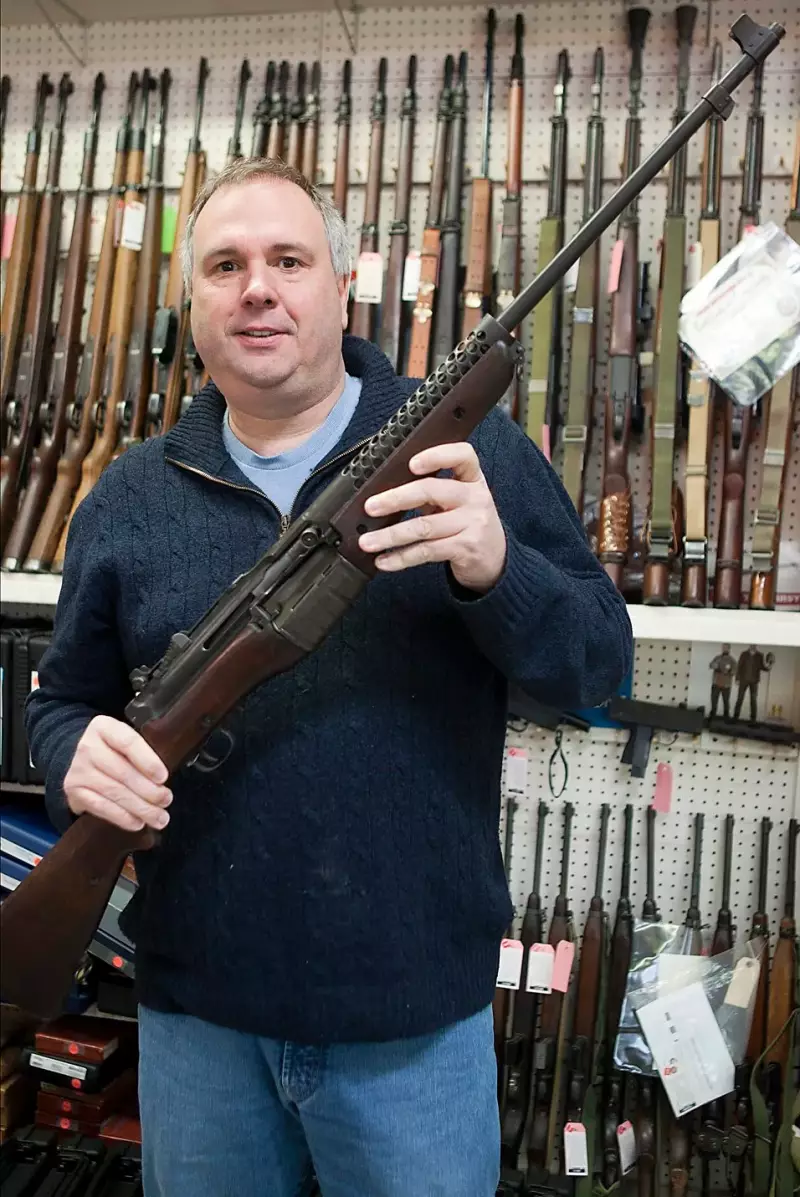
Collectors Firearms employee Brad Simpson holds a Johnson rifle number A0009, which previously belonged to Major Hugo Dunlop. The rifle was sold at auction after his death.
The Johnson system rifle, which was never adopted by the United States, left its mark on the American armory. stories. For this rifle, World War II was the very first and largest, but by no means the last conflict in which she took part. Then there were China, Indonesia and even Cuba, where these rifles ended up on both sides of the conflict, but that's a completely different story.
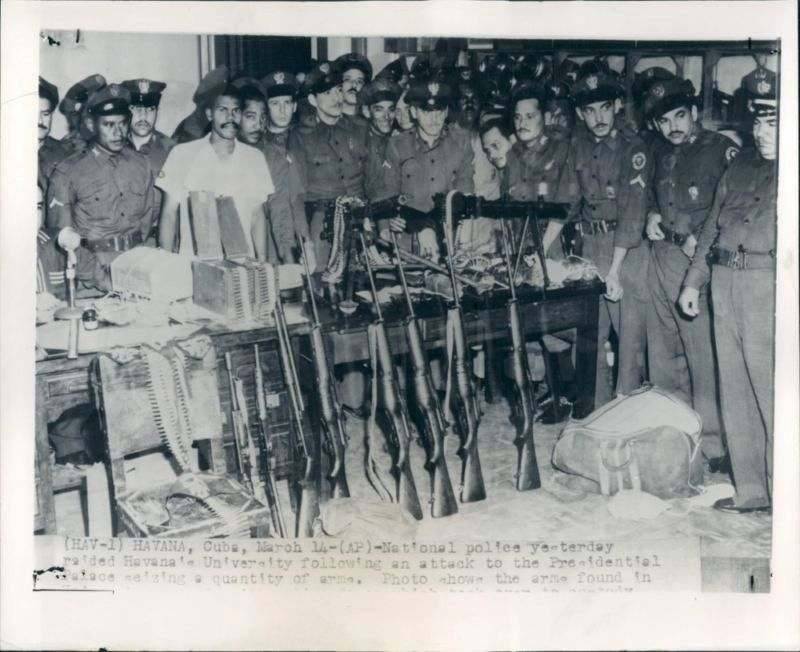
Cuban police officers display weapons seized from Castro guerrillas after the attack on the presidential palace, Havana, Cuba, 1957. Several Johnson rifles are displayed in front of the table.
Information